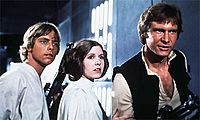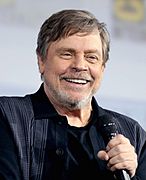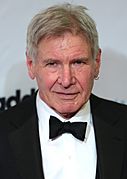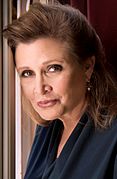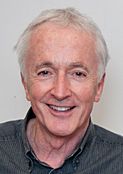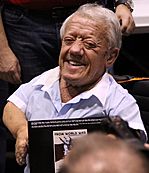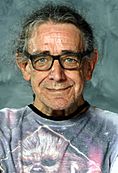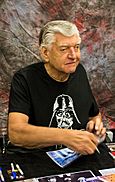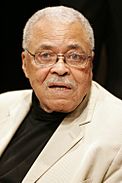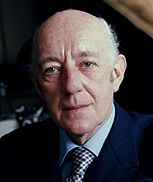Star Wars (film) facts for kids
Quick facts for kids Star Wars |
|
|---|---|
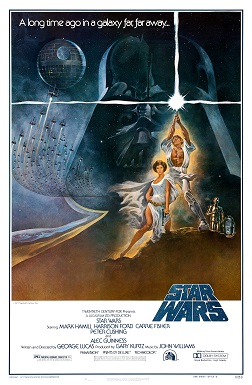
Theatrical release poster by Tom Jung
|
|
| Directed by | George Lucas |
| Produced by | Gary Kurtz |
| Written by | George Lucas |
| Starring | |
| Music by | John Williams |
| Cinematography | Gilbert Taylor |
| Editing by |
|
| Studio | Lucasfilm Ltd. |
| Distributed by | 20th Century-Fox |
| Release date(s) | May 25, 1977 |
| Running time | 121 minutes |
| Country | United States |
| Language | English |
| Budget | $11 million |
| Money made | $775.8 million |
Star Wars (also known as Star Wars: Episode IV – A New Hope) is a famous space opera movie from 1977. George Lucas wrote and directed this exciting film. It was the very first movie released in the Star Wars series. It also became the fourth story in the "Skywalker Saga" timeline.
The movie takes place "a long time ago in a galaxy far, far away." In this galaxy, a powerful and mean government called the Galactic Empire rules everything. The story follows a group of brave freedom fighters called the Rebel Alliance. They want to destroy the Empire's new super-weapon, the Death Star. When the Rebel leader, Princess Leia, is caught by the Empire, a young man named Luke Skywalker finds the secret plans for the Death Star. He sets off to rescue Leia. Along the way, he learns about a special power called "the Force" from an old Jedi Master named Obi-Wan Kenobi.
The movie stars Mark Hamill, Harrison Ford, Carrie Fisher, Peter Cushing, and Alec Guinness. Star Wars is seen as one of the greatest and most important movies ever made. It started a huge trend in pop culture. Many products like books, comics, video games, and toys were created. In 1989, the U.S. Library of Congress chose Star Wars to be saved in the National Film Registry. This means it's considered very important. The movie's amazing music was also added to the U.S. National Recording Registry in 2004.
Star Wars was followed by two more movies: The Empire Strikes Back (1980) and Return of the Jedi (1983). These three films make up the original Star Wars trilogy. Later, more movies were made, including a prequel series and a sequel trilogy. There are also two standalone films and many TV shows.
Contents
The Story of Star Wars
The movie begins during a big war in space. Spies for the Rebel Alliance have stolen secret plans. These plans are for the Empire's new weapon, the Death Star. This huge space station can destroy entire planets! Princess Leia Organa of Alderaan is a secret Rebel leader. She has the plans, but her ship is caught by an Imperial Star Destroyer. The evil Darth Vader leads the attack.
Before Leia is captured, she hides the plans. She puts them inside the memory of a robot called R2-D2. R2-D2 escapes in a small pod to the desert planet Tatooine. His robot friend, C-3PO, goes with him.
Luke's Journey Begins
Robot traders called Jawa find the droids. They sell them to farmers Owen and Beru Lars. These farmers are the aunt and uncle of Luke Skywalker. While Luke cleans R2-D2, he finds a holographic message. It's Leia asking for help from an old friend, Obi-Wan Kenobi.
Later, R2-D2 goes missing. While Luke searches, he is attacked by Sand People. An old man named Obi-Wan rescues Luke. Obi-Wan tells Luke about the Jedi Knights. They were peacekeepers who used a special energy field called the Force. The Empire hunted the Jedi, almost wiping them out. Luke learns his father was a Jedi. Vader, Obi-Wan's old student, turned evil and killed Luke's father. Obi-Wan gives Luke his father's old lightsaber, a Jedi weapon.
R2-D2 plays Leia's full message. She asks Obi-Wan to take the Death Star plans to Alderaan. She wants him to give them to her father, Bail Organa. Luke doesn't want to go at first. But then he finds that Imperial stormtroopers have killed his aunt and uncle. They also destroyed their farm while looking for the droids. Luke now has no choice but to go with Obi-Wan.
Finding Help and Escaping
Luke and Obi-Wan go to a cantina in Mos Eisley. They need to find a ride off the planet. They hire Han Solo, a smuggler who owes money to a gangster named Jabba the Hutt. Stormtroopers chase them. Obi-Wan, Luke, R2-D2, and C-3PO escape Tatooine. They fly with Han and his furry co-pilot, Chewbacca, on their ship, the Millennium Falcon.
Before the Falcon reaches Alderaan, the Death Star commander, Grand Moff Tarkin, destroys the planet. He forced Leia to tell him where the Rebel base was. When the Falcon arrives, the Death Star's tractor beam captures it. But the group hides in the ship's secret compartments. Obi-Wan leaves to turn off the tractor beam. Luke convinces Han and Chewbacca to help him rescue Leia. She is set to be executed.
After turning off the tractor beam, Obi-Wan fights Vader with lightsabers. Obi-Wan sacrifices himself so the others can escape the Death Star with Leia. The Empire uses a tracking device. They follow the Falcon to the hidden Rebel base on Yavin IV.
The Final Battle
The Death Star plans show a weak spot. It's a thermal exhaust port. If the Rebels hit it just right, it could destroy the whole station. Han leaves the Rebels to pay off Jabba. He takes his reward for rescuing Leia. Luke joins the Rebel X-wing starfighter squadron. They launch a desperate attack against the Death Star.
The Rebels lose many ships in the battle. Vader leads his own TIE fighters against them. Suddenly, Han and Chewbacca return in the Falcon to help! They knock Vader's ship off course before he can shoot Luke down. Luke hears Obi-Wan's spirit guiding him. He uses the Force to aim his torpedoes into the exhaust port. The Death Star explodes just moments before it can fire on the Rebel base. Back at the base, Leia gives Luke and Han medals for their bravery.
Meet the Characters
Middle: Anthony Daniels (2011), Kenny Baker (2012), Peter Mayhew (2015)
Bottom: David Prowse (2013), James Earl Jones (2013), Alec Guinness (1973)
- Mark Hamill as Luke Skywalker: A young man living on Tatooine. He dreams of a bigger life. He soon learns about the Force and the Jedi. George Lucas wanted new, young actors for the film. Mark Hamill was chosen for his intelligence and honesty.
- Harrison Ford as Han Solo: A tough smuggler and captain of the Millennium Falcon. Lucas first didn't want to cast Ford because he had worked with him before. But Ford helped other actors read lines. Lucas was so impressed that he gave Ford the role.
- Carrie Fisher as Princess Leia Organa: The princess of Alderaan. She is also a secret leader of the Rebel Alliance. Many young actresses tried out for this role. Carrie Fisher was cast, but she had to lose some weight for the part.
- Peter Cushing as Grand Moff Tarkin: The serious commander of the Death Star. Lucas first thought of Peter Cushing for Obi-Wan Kenobi. But he decided Cushing's sharp features were better for Tarkin. Lucas praised Cushing's acting.
- Alec Guinness as Obi-Wan Kenobi: An old Jedi Master and a hero from the Clone Wars. He teaches Luke about the Force. Lucas wanted a well-known actor for Obi-Wan. Japanese actor Toshiro Mifune was considered, but he turned it down. Alec Guinness agreed to the role. He believed the movie would be a success. He even got a percentage of the film's earnings.
- Anthony Daniels as C-3PO: A polite robot who can speak over six million languages. Daniels wanted the role after seeing a drawing of C-3PO's face. He felt the robot looked vulnerable. Daniels also provided C-3PO's voice.
- Kenny Baker as R2-D2: A small robot and C-3PO's friend. He carries the Death Star plans and Leia's secret message. Kenny Baker was 3 feet 8 inches tall. He was cast because he was small enough to fit inside the R2-D2 suit. He first said no to the role three times.
- Peter Mayhew as Chewbacca: A tall, furry Wookiee. He is Han Solo's loyal co-pilot on the Millennium Falcon. Peter Mayhew was 7 feet 3 inches tall. When he stood up to greet George Lucas, Lucas immediately knew he had found Chewbacca. Mayhew studied animals at zoos to help him play Chewbacca.
- David Prowse as Darth Vader: Obi-Wan's old Jedi student who turned evil. Prowse was offered the role of Chewbacca first. But he wanted to play the villain. Lucas decided Prowse's voice wasn't right for Vader.
- James Earl Jones as the voice of Darth Vader. He was not credited until 1983. Lucas wanted a powerful voice for Vader. He chose James Earl Jones because his voice was strong and less familiar to audiences.
Other actors include Phil Brown and Shelagh Fraser as Luke's Uncle Owen and Aunt Beru. Denis Lawson plays Rebel pilot Wedge Antilles. Garrick Hagon plays Biggs Darklighter, Luke's childhood friend.
How Star Wars Changed Movies
Star Wars helped launch the careers of many actors. These include Mark Hamill, Harrison Ford, and Carrie Fisher. Harrison Ford later starred in the Indiana Jones movies. He said Star Wars really helped his career. He felt lucky that his movies were enjoyed by new generations.
The film also led to the Star Wars Holiday Special in 1978. This TV special is often seen as a big mistake. George Lucas himself didn't like it. It was only shown once on TV and never officially released. But many unofficial copies exist, making it a famous "lost" show.
Its Impact on Filmmaking
Many experts say Star Wars was a huge step forward for movies. It changed how special effects were made. It also created a new kind of exciting, fast-paced movie. Along with Steven Spielberg's Jaws, Star Wars changed Hollywood. Movies started focusing on big, exciting "blockbusters" for younger audiences.
Many famous filmmakers say Star Wars influenced them. These include James Cameron, J. J. Abrams, and Christopher Nolan. Directors like Ridley Scott and Peter Jackson were inspired by Lucas's idea of a "used future." This means vehicles and places look old and worn, making the world feel real. Jackson used this idea in The Lord of the Rings movies.
Some critics felt Star Wars made Hollywood focus too much on simple fun. They thought it moved away from more "serious" films. But others argued that Star Wars brought movies back to their roots. It reminded people that films can be like a magic show, full of special effects and wonder.
Awards and Recognition
Time magazine called Star Wars the "Movie of the Year" in 1977. They said it was a "grand and glorious film." They also called its special effects "most ingenious."
Star Wars has been very popular in many polls. In 2008, Americans voted it the second most popular film. In 2002, it was voted one of the greatest films ever made by Channel 4. In 2011, ABC and People magazine fans chose it as the Best Sci-Fi Film.
Many important publications have also listed Star Wars among the best films. Empire magazine ranked it No. 22 on its "500 Greatest Movies of All Time" list. Time magazine and The New York Times also included it in their lists of greatest films.
In 1989, the U.S. Library of Congress chose Star Wars for the National Film Registry. This means it's important for American culture and history. It was one of the first films chosen. In 1991, it was added to the Producers Guild of America's Hall of Fame. The movie's amazing music was also added to the U.S. National Recording Registry in 2004.
The American Film Institute (AFI) has honored Star Wars many times. It's ranked first for film scores and second for sci-fi films. It's also on lists for thrilling movies and inspiring movies. The famous line "May the Force be with you" is ranked eighth on AFI's list of best movie quotes.
More Star Wars Stories
A radio show based on the movie was made in 1981. It was played on National Public Radio (NPR). George Lucas helped with it. The original music and sound effects were used. Mark Hamill and Anthony Daniels even played their characters again! The radio show added new scenes not seen in the movie.
Star Wars was followed by The Empire Strikes Back in 1980 and Return of the Jedi in 1983. These movies finished the first three-movie series. They were also very successful and loved by critics. This original group of three movies is considered one of the best film trilogies ever.
22 years after Star Wars, George Lucas made a new series of three movies. These were called the prequel trilogy. They included The Phantom Menace (1999), Attack of the Clones (2002), and Revenge of the Sith (2005). These films tell the story of Obi-Wan Kenobi and Anakin Skywalker. They show how Anakin becomes the evil Darth Vader. The prequel movies made a lot of money. But some fans and critics had mixed feelings about them.
In 2012, Lucas sold the Star Wars stories to The Walt Disney Company. Disney then made a new series of three movies. This was the sequel trilogy. It included The Force Awakens (2015), The Last Jedi (2017), and The Rise of Skywalker (2019). Actors from the original movies like Harrison Ford, Mark Hamill, and Carrie Fisher returned. New characters were played by Daisy Ridley, John Boyega, and others. Disney has also released standalone films and TV shows. These explore other adventures in the Star Wars galaxy.
See also
 In Spanish: Star Wars: Episodio IV - Una nueva esperanza para niños
In Spanish: Star Wars: Episodio IV - Una nueva esperanza para niños


